| I
first became interested in Dressage in the early '70s. We knew a young
woman. Belinda Nairn (Boudin), who was just beginning to ride and show
her horse in Dressage, and asked her if she wanted to work with our three-year-old
Davenport stallion, Anchorage (Ibn Alamein x Alaska). As time went on we
found that she had a world of natural talent. (Belinda was on the U.S.
Olympic Dressage team in 1988.) In 1975, she started Anchorage and two
years later made IAHA Top Ten in both 1st and 2nd Levels based on scores
in open, all breed competition. (At that time the IAHA did not yet offer
the classes at the Nationals, so the Top Tens were named on the basis of
scores, earned in Arab or Open shows, which were submitted to them.)
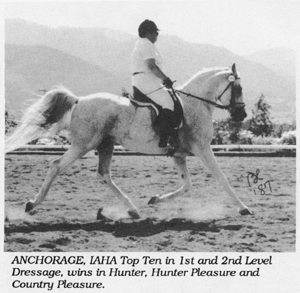 In
1978, before we sold him, Anchorage was doing very well in 3rd Level. He
was never defeated by another Arabian and over half of his ribbons were
blues, primarily against Thoroughbreds and Warmblood competition. In addition
to being a Dressage horse, he was ridden for pleasure and on the trail
by myself and our daughter. Anchorage is now owned by Keatha Senyohl of
Washington, who has shown him to several wins in Open Dressage and in 1987
and 1988 to wins in Arabian Country English Pleasure, Show Hack, and Hunter
Pleasure. Keatha is a professional trainer in Dressage, Hunter-Jumper,
Western Pleasure, etc. and plans to start Anchorage in Harness this year
at age 18! In
1978, before we sold him, Anchorage was doing very well in 3rd Level. He
was never defeated by another Arabian and over half of his ribbons were
blues, primarily against Thoroughbreds and Warmblood competition. In addition
to being a Dressage horse, he was ridden for pleasure and on the trail
by myself and our daughter. Anchorage is now owned by Keatha Senyohl of
Washington, who has shown him to several wins in Open Dressage and in 1987
and 1988 to wins in Arabian Country English Pleasure, Show Hack, and Hunter
Pleasure. Keatha is a professional trainer in Dressage, Hunter-Jumper,
Western Pleasure, etc. and plans to start Anchorage in Harness this year
at age 18!
A
number of years ago, a young Davenport stallion was sent to Alice Martin's
stable to be sold after his owner had died. Mr. Bob Allen happened to stop
by. He had always wanted to ride, and had heard that Alice gave lessons.
He fell in love with Au Contraire (Dharanad x June), and bought him, though
he hadn't even started his training. They would learn together! "AC",
as the stallion is affectionately called, was left with Alice for training,
and Bob started riding lessons. "AC" has a very powerful trot,
and being green as grass himself, was an unlikely candidate for teaching
someone over thirty to ride. After only a few months, Bob was taking lessons
on AC, and within a year was showing him in Training Level, while Alice
showed him in 1st level. Unfortunately AC suffered an injury at the 1988
Nationals where he was competing in 2nd Level. Bob has since advanced to
1st Level riding and is learning the 2nd Level movements, 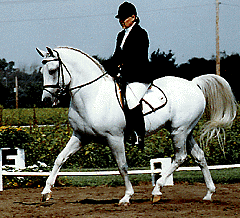 while
AC was twice Champion 3rd Level horse in 1989, with average scores of 64%,
and is well into 4th Level work. AC is also shown in PAS de Deux, or Dressage
pairs, and has taken part in several of Alice's locally famous Quadrilles
which are made up of eight grey Arabians, mostly Sir offspring, and in
the ten horse Quadrille made up of nine Davenport stallions and one Davenport
geldings. while
AC was twice Champion 3rd Level horse in 1989, with average scores of 64%,
and is well into 4th Level work. AC is also shown in PAS de Deux, or Dressage
pairs, and has taken part in several of Alice's locally famous Quadrilles
which are made up of eight grey Arabians, mostly Sir offspring, and in
the ten horse Quadrille made up of nine Davenport stallions and one Davenport
geldings.
Au
Contraire (Dharanad X June) 1991 photo ridden
by Alice Martin
Kathleen
Dailey is the owner of StarSirGalahad, half-Davenport gelding by Sir, and
shares training and showing honors with Alice Martin. At the Nationals
in 1988, Galahad was Top Ten in 1st Level with Alice showing.
Another
Sir son, Star Sir Galadar is owned by Laura Cadagin who bought him as a
very green Western Pleasure horse. She did his training and showing under
Alice's tutelage. In 1988 he won the top award for the United States Dressage
Federation Training Level All-Breeds competition. In 1989 he had fine scores
in 1st Level in Open and All-Arabian shows.
Judith
Franklin from Michigan has trained and shown her two Davenport stallions
to several wins with very good scores. Major General (Tripoli x Major Barbara),
is showing in 1st and 2nd Level while the younger Chataqua (Monsoon x Verona),
is in Training and 1st Level. Judith also uses both her stallions for trail
riding.
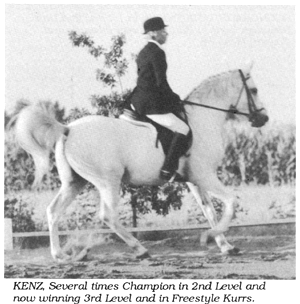 Dosia
Mann not only bred her Davenport gelding, Kenz (Lysander x Rehadla), and
raised him on a bottle, she has done all his training and showing, Kenz
has been several times Champion at 2nd Level and has also done extremely
well at 3rd Level with limited showing. In addition to the regular tests,
Dressage offers the opportunity to perform freestyle tests which are set
to music which are called Kurrs. Kenz certainly has musical talent. He
will pick up the rhythm of any music and will alter his stride to match
the music. It's as though he has a built in metronome and Dosia has done
well in Kurrs with her gelding. Dosia
Mann not only bred her Davenport gelding, Kenz (Lysander x Rehadla), and
raised him on a bottle, she has done all his training and showing, Kenz
has been several times Champion at 2nd Level and has also done extremely
well at 3rd Level with limited showing. In addition to the regular tests,
Dressage offers the opportunity to perform freestyle tests which are set
to music which are called Kurrs. Kenz certainly has musical talent. He
will pick up the rhythm of any music and will alter his stride to match
the music. It's as though he has a built in metronome and Dosia has done
well in Kurrs with her gelding.
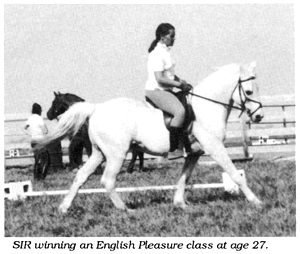 According
to the propaganda, Arabians are supposed to live long lives and stay sound
and useful. I don't know about Arabs in general, but Davenports often prove
to do so. I mentioned Sir as being still hail and hardy at 32. He won an
English Pleasure class the last time he was shown, five years ago. I don't
believe he was ever shown in Dressage, but his successful get and grandget
make up for it. His brother, Janan Abinoam According
to the propaganda, Arabians are supposed to live long lives and stay sound
and useful. I don't know about Arabs in general, but Davenports often prove
to do so. I mentioned Sir as being still hail and hardy at 32. He won an
English Pleasure class the last time he was shown, five years ago. I don't
believe he was ever shown in Dressage, but his successful get and grandget
make up for it. His brother, Janan Abinoam
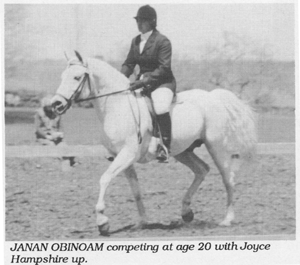 began
his Dressage career at the age of 18 and continued to show until colic
surgery cut short his competitive career (but not his life) at 22. His
owner, Joyce Hampshire often gave 3rd and 4th Level demonstra- tions with
this fine old gentleman. Before starting his dressage career, "Binnie"
was successfully shown in English Pleasure classes and was the sire of
a number of part Davenport show winners on the East coast. Another Davenport
stallion owned by Joyce is Hellas (Ibn Alamein x Ionia), the 1989 Massachusetts
High Point Arabian in 2nd Level in Open shows and Hi Point Dressage horse
at the Massachusetts All Arabian Show. Hellas was Reserve Championship
in both Hunter (over fences) and Hunter Pleasure classes and has given
a number of exhibitions in which he performs 1st Level tests, including
serpentines across the arena and halts from the trot, without a bridle. began
his Dressage career at the age of 18 and continued to show until colic
surgery cut short his competitive career (but not his life) at 22. His
owner, Joyce Hampshire often gave 3rd and 4th Level demonstra- tions with
this fine old gentleman. Before starting his dressage career, "Binnie"
was successfully shown in English Pleasure classes and was the sire of
a number of part Davenport show winners on the East coast. Another Davenport
stallion owned by Joyce is Hellas (Ibn Alamein x Ionia), the 1989 Massachusetts
High Point Arabian in 2nd Level in Open shows and Hi Point Dressage horse
at the Massachusetts All Arabian Show. Hellas was Reserve Championship
in both Hunter (over fences) and Hunter Pleasure classes and has given
a number of exhibitions in which he performs 1st Level tests, including
serpentines across the arena and halts from the trot, without a bridle.
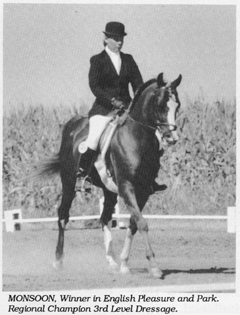 Over
the years Charles Craver has trained and successfully shown more than a
score of his home-bred Davenports in English Pleasure and Park Horse classes.
Although he still does his own training and rides as much as possible,
his busy schedule rarely allows him to show now. One of his former EP Champions,
Monsoon (Tripoli x Ceres), began his Dressage training with Alice at age
17. At the age of 21, he was Regional Champion in 3rd Level. Over
the years Charles Craver has trained and successfully shown more than a
score of his home-bred Davenports in English Pleasure and Park Horse classes.
Although he still does his own training and rides as much as possible,
his busy schedule rarely allows him to show now. One of his former EP Champions,
Monsoon (Tripoli x Ceres), began his Dressage training with Alice at age
17. At the age of 21, he was Regional Champion in 3rd Level.
North
of the border, Frank Haneschlager of British Columbia, trains and shows
his Davenport stallions in Dressage Driving, as well as Obstacle and Cross
Country Driving competitions. Mariner (Prince Hal x Iras), Briganteen (Tripoli
x Portia), and HB Aurelius (Briganteen x Octavia), as well as several half
Davenport sons of Mariner, have all competed both as singles and in double
harness. Briganteen and Mariner also took part in the triumphal march in
the opera Aida last year, along with tigers, an elephant, and other assorted
animals.
Our
daughter, Diane, has a Davenport gelding (Monsoon x Tara) which she has
had since he was a yearling and she was seven. Except for his first two
months under saddle, she did all his training, mostly on the trails with
friends. She showed him in every class she could think of. She never had
a competitive attitude about showing, but showed for fun. When she was
13, she entered the Arizona Dressage 1st Level Futurity. There were 16
entries, and while she was the only rider under 21, placed fourth, and
was the only Arabian to get a ribbon. Years later, after a four-year layoff
while in college, she showed him to a 1st, a 2nd, and a 3rd om 1st Level.
Eighty-four
years ago when Homer Davenport went to the desert to obtain Arabian horses,
a horse with heart as well as agility would have been essential
and a great asset to the Bedouins. Their very lives depended upon these
horses! It's interesting that Davenport made a special effort to acquire
only those animals which the Bedouins themselves would use for breeding,
rather than those which might be for sale to anyone. Perhaps therin lies
the explanation of why Davenports have heart. Today's living Davenport
Arabians are the result of breedings made only within their own group since
1906.
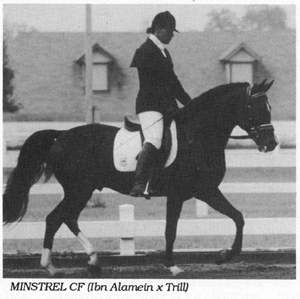 Davenports
are superbly satisfactory show horses in Dressage or in any other equine
activity, plus they have everything a Bedouin Arabian horse should have;
pedigree, balanced conformation, type, temperament and heart! Davenports
are superbly satisfactory show horses in Dressage or in any other equine
activity, plus they have everything a Bedouin Arabian horse should have;
pedigree, balanced conformation, type, temperament and heart!
Come
Visit Our
DAVENPORT
BULLETIN BOARD
Return to the C.
Lyon's Collection of Articles
Return to our Table
of Contents Page
Come visit our Family horses
Davenports: a Unique
Breeding Group
More Davenport Sites and other Interesting
Paces to Visit
|
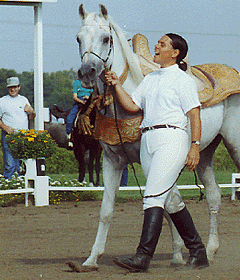
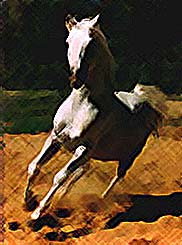
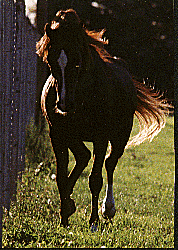
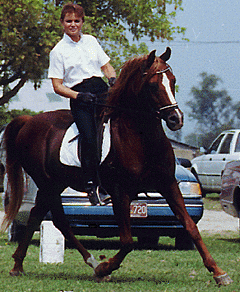 the
ground. The person who really enjoys riding a fine horse can't help but
think: "What balance! What agility! What power and natural cadence!"
And then, in the words of Charles Craver: "Oh, to ride such a horse!
the
ground. The person who really enjoys riding a fine horse can't help but
think: "What balance! What agility! What power and natural cadence!"
And then, in the words of Charles Craver: "Oh, to ride such a horse!
